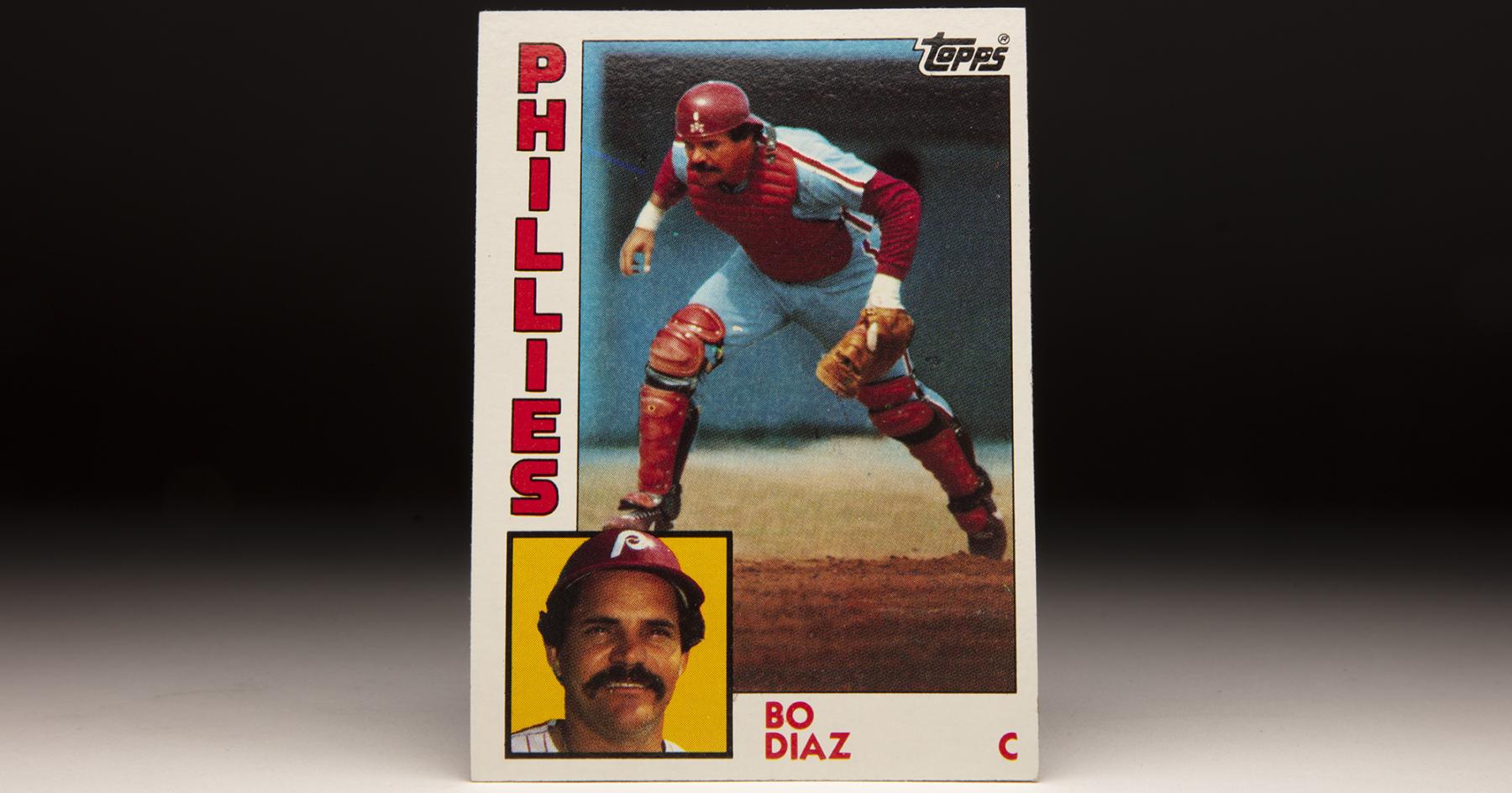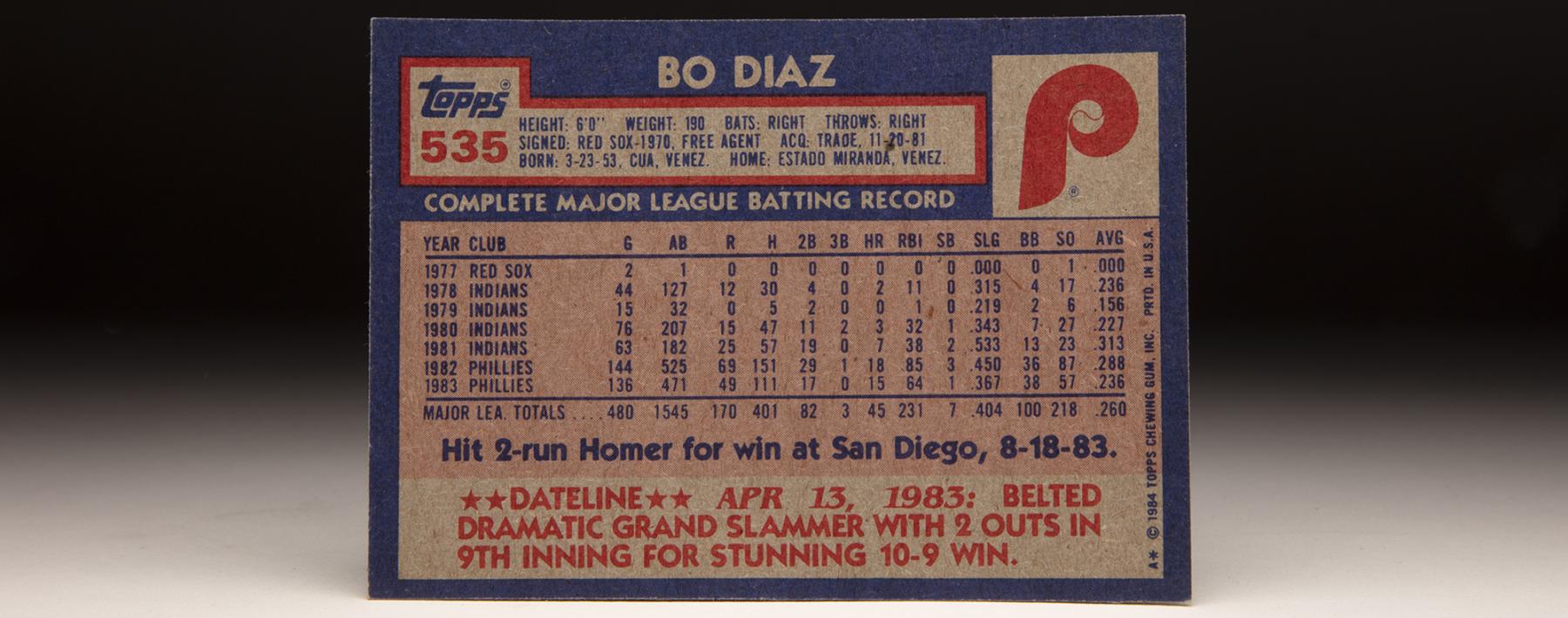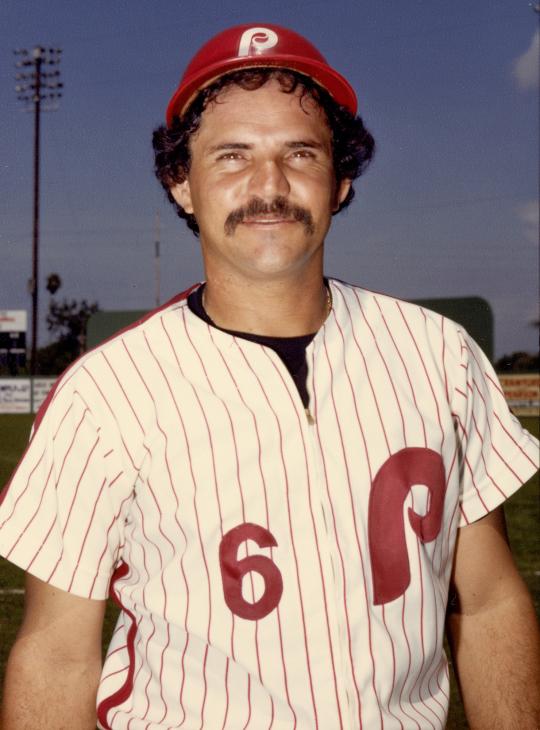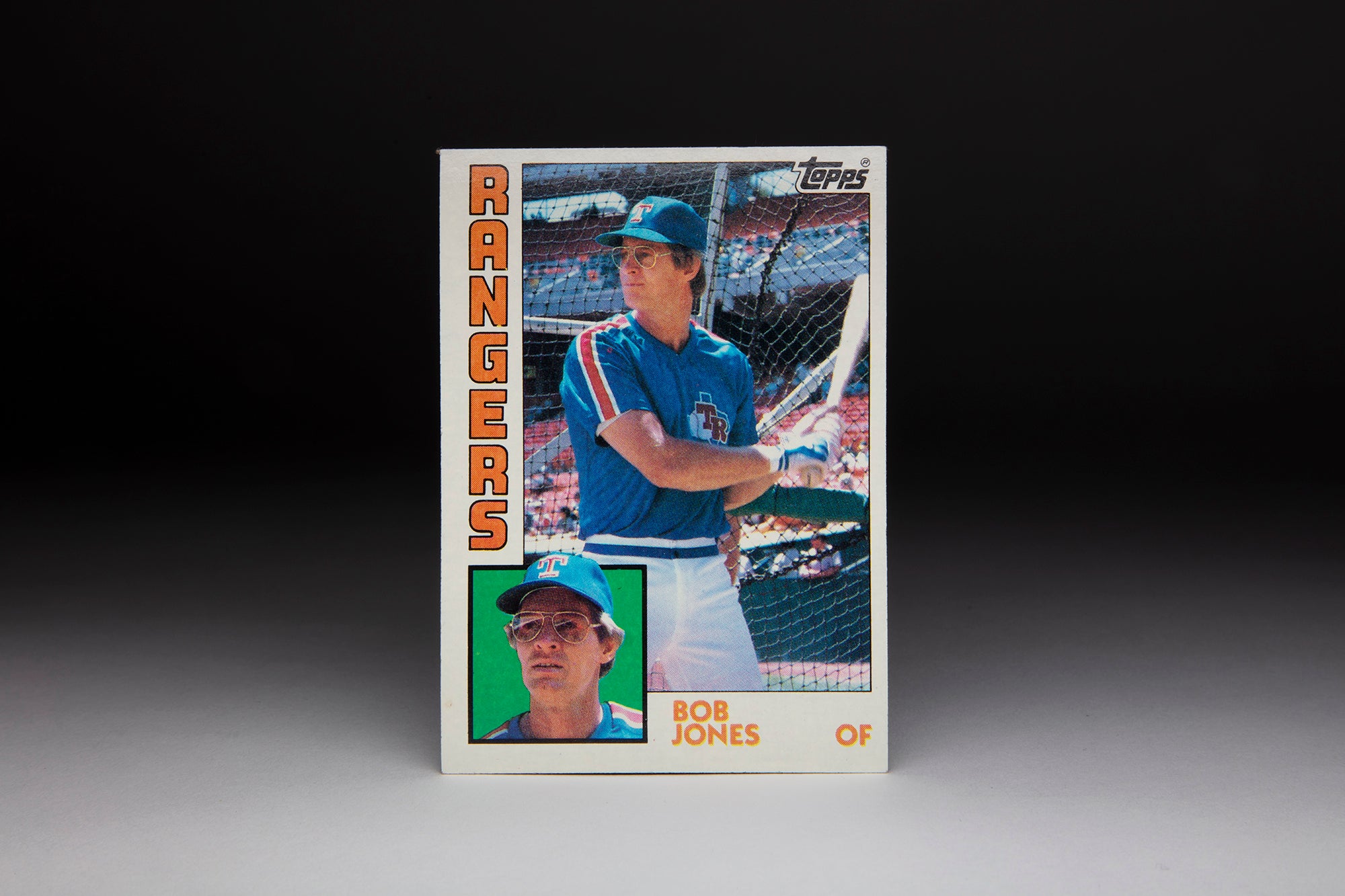- Home
- Our Stories
- #CardCorner: 1984 Topps Bo Díaz
#CardCorner: 1984 Topps Bo Díaz
A slugging catcher who held the Venezuelan Winter League single-season home run record for more than a quarter of a century, Bo Díaz’s life – which might have included additional big league seasons – ended in a tragic accident on the day after Thanksgiving in 1990.
But Díaz turned his desire and grit – along with a powerful throwing arm – into 13 MLB campaigns that made him a hero in his homeland.
Baudilio Jose Díaz was born March 23, 1953, in Cúa, Venezuela. He would begin playing in organized youth baseball leagues at the age of eight and eventually left school to help support his family. At 16, Díaz was eligible for his nation’s army and faced a future fighting insurrectionists in the mountains.
“The reason I became a professional was to escape the army,” Díaz told the Philadelphia Inquirer in 1982. “I don’t think I was afraid to go, I just didn’t want to give my parents a hard time.”
Signed by the Red Sox on Christmas Day in 1970, Díaz – who spoke almost no English – was injured for much of the 1971 season after hurting his knee late in the year. He played in only 14 games with Class A Winter Haven in 1972 after undergoing knee surgery and then 25 more with Elmira of the New York-Penn League in 1973, living at the YMCA for much of the year.
Healthy in 1974, Díaz hit .242 over 97 games with Winter Haven and demonstrated his powerful throwing arm with 75 assists. He hit .263 with Winston-Salem of the Carolina League in 1975 and then made it to Triple-A in 1976. Finally in 1977, Díaz got onto the Red Sox’s radar as a legitimate prospect by hitting .263 with seven homers and 54 RBI in 105 games for Pawtucket in the International League.
The Red Sox brought Díaz to the majors in September of that year and he appeared in two games down the stretch. Then on March 30, 1978, Díaz became a major piece of a blockbuster trade when the Red Sox acquired Dennis Eckersley and Fred Kendall from Cleveland in exchange for Ted Cox, Mike Paxton, Rick Wise and Díaz.
Cox was considered the major prospect in the deal, and the Cleveland media almost unanimously roasted general manager Phil Seghi for trading Eckersley, who had three excellent seasons under his belt and was not yet 24 years old. But the Indians needed a young catcher, and Díaz fit the description.
“Next to Johnny Bench, Díaz has the best arm I’ve ever seen,” Cleveland scout Jack Cassini told the Associated Press. “This is going to go down as one of the best deals Cleveland ever made.”
It didn’t work out that way. Eckersley won 20 games for the Red Sox in 1978 and a decade later would become one of the game’s best relievers en route to a plaque in Cooperstown. Díaz, however, would become an All-Star catcher – albeit not overnight.
Díaz made Cleveland’s 1978 Opening Day roster – after winning MVP honors in the 1977-78 Venezuelan Winter League – but broke his right ankle sliding into second base against the Royals on April 15, which led to the call-up of another promising young catcher: Ron Hassey. Díaz did not return to the lineup until June 18 and appeared in 44 games that season, hitting .236.
“I felt so bad (after the injury),” Díaz told the Akron Beacon Journal. “I went home to Venezuela and I thought: ‘I don’t want to go back.’ I thought I’d never play again.”
In 1979, the Indians committed to promising young catcher Gary Alexander behind the plate, and Hassey won the backup job. Díaz appeared in just 15 games for Cleveland that year, spending much of the season on the shelf with a broken index finger and sprained thumb as well as a stint at Triple-A Tacoma.
But Alexander struggled at the plate and in the field that year, prompting Cleveland to turn to Hassey and Díaz in 1980 – with Díaz appearing especially promising after hitting a record 20 home runs in the 1979-80 Venezuelan Winter League campaign, a mark that stood for three decades.
Hassey hit .318 in 1980 while Díaz batted just .227 as his main backup. But in 1981, Hassey injured a knee and Díaz took advantage by hitting .313 in 63 games, earning a spot in the All-Star Game that was played at Cleveland’s Municipal Stadium.
Suddenly, the Indians had two of the rarest commodities in baseball: Catchers with the ability to hit .300.
On Nov. 20, 1981, Cleveland dealt from its position of strength by sending Díaz to the Phillies in a three-team deal that brought pitchers Silvio Martinez, Scott Munninghoff and Lary Sorensen to the Indians and sent Lonnie Smith to the Cardinals.
“We had to give up an outstanding player to get (Díaz) in Lonnie Smith,” Phillies manager Pat Corrales told the Philadelphia Inquirer. “(But) so is Bo. This guy can beat you with one swing. He’s got enough talent to be an all-star catcher.”
Díaz didn’t make the NL All-Star Game roster in 1982 but was one of the Phillies’ best players, hitting .288 with 29 doubles, 18 homers and 85 RBI. The Phillies rewarded him with a four-year deal worth a reported $2 million that also included a fifth-year club option.
The following year, Díaz hit just .236 but contributed 15 homers and 64 RBI as the Phillies stormed to the NL East title with a furious closing rush. Díaz hit .333 over the season’s final two weeks and the Phillies won 13 of the final 15 games he played. Díaz was also part of history when he caught Steve Carlton’s 300th win on Sept. 23.
Díaz hit .154 in the Phillies’ four-game victory over the Dodgers in the NLCS then totaled five hits in Philadelphia’s five-game loss to the Orioles in the World Series. He was denied a Fall Classic homer in Game 1 when Baltimore’s John Lowenstein reached over the left field fence at Memorial Stadium and brought Díaz’s fly ball back into the park.
Though the World Series ended in disappointment for Díaz and the Phillies, Díaz made headlines around the country with a story told by Orioles catcher Rick Dempsey, who was a teammate of Díaz with Caracas in the Venezuelan Winter League in 1973.
The tale began when Dempsey had an altercation with fans after a game.
“After the game, I came out of the park with two of my teammates,” Dempsey told The New York Times News Service. “A little guy about 5-foot-2 came up and kicked me in the ribs and so I turned around and smacked him and then I jumped into (a) cab. People converged on the cab. They were trying to break the windows. Then Bo Díaz jumped in the front seat…and we started to drive out the front gate. Then I saw the little guy who kicked me. He was running up to the car with a brick, and he threw it through the windshield and hit Díaz. The broken glass cut a vein in Bo’s neck.
“There was blood coming out of (Díaz’s) neck like you wouldn’t believe, I mean, in spurts. Bo lost consciousness and slumped in the seat. I took off my catcher’s pad from my back pocket and stuck the pad on Bo’s neck to stop the bleeding. It kept him alive.
“Well, Bo would turn out fine, of course, but if you see him today he still has the scars on his neck from that night.”
Díaz also had emotional scars from the 1983 season when the media was critical of his play. As a result, Díaz did not talk to the media in Spring Training of 1984. He virtually skipped the 1983-84 Venezuelan Winter League season at the Phillies’ request but hurt his left knee in a late-April play at the plate, causing him to miss all of May and most of June. He returned for a handful of games during the summer but eventually underwent surgery, limiting him to 27 games and a .213 batting average that season.
Ozzie Virgil took over behind the plate for the Phillies in 1984 and hit 18 home runs, putting Díaz’s future with the club in jeopardy. After appearing in just 26 games in 1985, Díaz was traded to the Reds along with a minor leaguer on Aug. 8 of that year in exchange for Tom Foley, Alan Knicely and Freddie Toliver.
“Those other guys (Reds catchers in 1985) did fine jobs,” Reds general manager Bill Bergesch told the Associated Press after the trade. “But when you get the chance to get Bo Díaz, you jump at it.”
With Reds manager Pete Rose charging toward the all-time hits record that season, Díaz quickly became a favorite of the manager and his new teammates. He hit .261 in 51 games while immediately stepping in as Cincinnati’s starting catcher.
Díaz led with his play in 1986, hitting .272 with 10 homers and 56 RBI in 134 games.
“He really solidified things behind the plate,” future Hall of Famer Barry Larkin told the Cincinnati Enquirer when Díaz passed away in 1990. “We were young, and Bo showed us a lot of leadership. He was quiet, but he led by example.”
He was even better in 1987, earning his second All-Star Game berth while hitting .270 with 28 doubles, 15 homers and 82 RBI. At the All-Star Game, Díaz ended his self-imposed silence with the media.
“It has helped a lot,” Díaz told the AP of his decision not to speak to the press. “Because when the game is over, I’ve put everything into the game. I don’t have to worry about (being interviewed).”
The Reds signed Díaz to a two-year extension following the season, but the grind of catching began to wear down Díaz in 1988 when he appeared in just 92 games and hit .219. Then in the spring of 1989, Díaz’s young son, Joshua, was diagnosed with a brain tumor that required surgery.
“I was driving myself crazy, because I wanted to get back to the level I was capable of playing baseball,” Díaz told the Enquirer. “But I just couldn’t really find a way to concentrate on the game, knowing my boy was sick.”
Díaz appeared in just 43 games in 1989 as his left knee once again forced him out of action. His final game came on July 9, and with his contract expiring after the season the Reds did not bring him back for 1990. That was the year Cincinnati led the NL West wire-to-wire and captured the World Series title. Díaz watched the postseason on television from his home in Venezuela and was contemplating a comeback – playing winter league ball and enjoying time with his family and son, who recovered from the surgery.
On Nov. 23, 1990, Díaz was adjusting the satellite dish at his home when the dish collapsed on his neck, ending his life almost instantly. He finished his 13-year big league career with a .255 batting average, 162 doubles, 87 home runs and 452 RBI.
“He went about his job in a very businesslike fashion,” Reds teammate Eric Davis told the Enquirer. “When Bo wasn’t playing, you knew he had to be hurt, because he was so tough.”
Craig Muder is the director of communications for the National Baseball Hall of Fame and Museum






